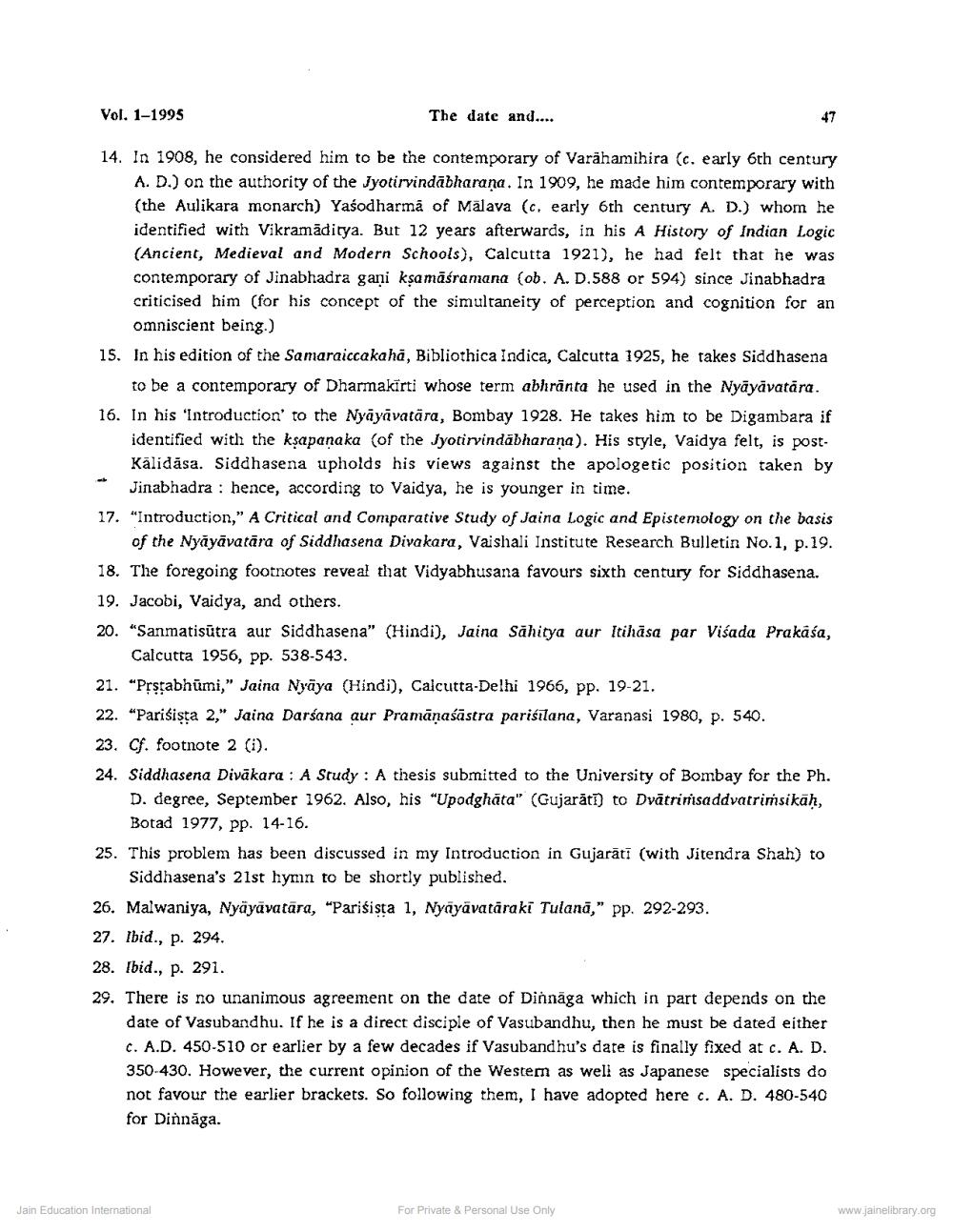Book Title: Date and Authorship of Nyayavatara Author(s): M A Dhaky Publisher: Z_Nirgrantha_1_022701.pdf and Nirgrantha_2_022702.pdf and Nirgrantha_3_022703.pdf View full book textPage 9
________________ Vol. 1-1995 The date and.... 14. In 1908, he considered him to be the contemporary of Varahamihira (c. early 6th century A. D.) on the authority of the Jyotirvindābharana. In 1909, he made him contemporary with (the Aulikara monarch) Yaśodharma of Mālava (c. early 6th century A. D.) whom he identified with Vikramāditya. But 12 years afterwards, in his A History of Indian Logic (Ancient, Medieval and Modern Schools), Calcutta 1921), he had felt that he was contemporary of Jinabhadra gani ksa māśramana (ob. A. D.588 or 594) since Jinabhadra criticised him (for his concept of the simultaneity of perception and cognition for an omniscient being.) 15. In his edition of the Samaraiccakaha, Bibliothica Indica, Calcutta 1925, he takes Siddhasena to be a contemporary of Dharmakirti whose term abhrānta he used in the Nyāyāvatāra. 16. In his 'Introduction to the Nyāyāvatāra, Bombay 1928. He takes him to be Digambara if identified with the kşapanaka (of the Jyotirvindábharana). His style, Vaidya felt, is postKalidasa. Siddhasena upholds his views against the apologetic position taken by Jinabhadra : hence, according to Vaidya, he is younger in time. 17. "Introduction," A Critical and Comparative Study of Jaina Logic and Epistemology on the basis of the Nyāyāvatāra of Siddhasena Divakara, Vaishali Institute Research Bulletin No.1, p.19. 18. The foregoing footnotes reveal that Vidyabhusana favours sixth century for Siddhasena. 19. Jacobi, Vaidya, and others. 20. "Sanmatisūtra aur Siddhasena" (Hindi), Jaina Sahitya aur Itihāsa par Visada Prakasa, Calcutta 1956, pp. 538-543. 21. “Prstabhūmi," Jaina Nyāya (Hindi), Calcutta-Delhi 1966, pp. 19-21. 22. “Parisista 2," Jaina Darsana aur Pramānaśāstra pariśīlana, Varanasi 1980, p. 540. 23. Cf. footnote 2 (i). 24. Siddhasena Divakara : A Study: A thesis submitted to the University of Bombay for the Ph. D. degree, September 1962. Also, his "Upodghăta" (Gujarātī) to Dvātrimsaddvatrimsikāh, Botad 1977, pp. 14-16. 25. This problem has been discussed in my Introduction in Gujarāti (with Jitendra Shah) to Siddhasena's 21st hymn to be shortly published. 26. Malwaniya, Nyäyāvatāra, "Parisista 1, Nyāyāvatāraki Tulanā," pp. 292-293. 27. Ibid., p. 294. 28. Ibid., p. 291. 29. There is no unanimous agreement on the date of Dinnāga which in part depends on the date of Vasubandhu. If he is a direct disciple of Vasubandhu, then he must be dated either C. A.D. 450-510 or earlier by a few decades if Vasubandhu's date is finally fixed at c. A. D. 350-430. However, the current opinion of the Westem as well as Japanese specialists do not favour the earlier brackets. So following them, I have adopted here c. A. D. 480-540 for Dinnaga. Jain Education International For Private & Personal Use Only www.jainelibrary.orgPage Navigation
1 ... 7 8 9 10 11
